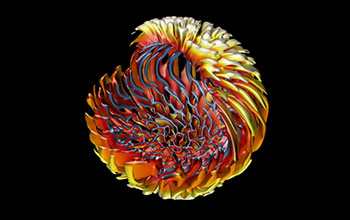Multimedia Gallery
Inside view of rapidly spinning star (Image 1)
A computer generated image of visualized variables from a star simulation dataset generated with Anelastic Spherical Harmonic code on the Ranger supercomputer at the Texas Advanced Computing Center at the University of Texas at Austin. This simulated star is similar to our sun in mass and composition but spinning five times faster.
Stars like the sun harbor vigorous regions of intense turbulence below their seemingly calm surfaces. The turbulent motions are known as convection and they arise from the searing heat produced deep in the stellar core. Stars also spin, and the younger they are the faster they spin. These spinning and churning motions convert kinetic energy into magnetic energy, which powers the rich display of stellar activity and variability that are observed.
The key to unlocking the dynamics of stellar interiors is something called the Reynolds stress. This describes how motions inside stars redistribute momentum and is therefore responsible for the differential rotation (fast equator, slow poles). This in turn has close links to the history of astronomy as a human endeavor and to the latest and greatest NASA missions today.
[Research supported in part by National Science Foundation (NSF) grant AST 09-02004., a postdoctoral fellowship awarded to Benjamin Brown by NSF's Astronomy Division.]
The video from which this still came, "Inside Views of Rapidly Spinning Star," can be viewed Here. (Date image taken: 2012; date originally posted to NSF Multimedia Gallery: Nov. 10, 2015) [Image 1 of 2 related images. See Image 2.]
Credit: Visualization: Greg Foss and Greg Abram, Texas Advanced Computing Center; science: Ben Brown, University of Wisconsin-Madison, and Mark Miesch, National Center for Atmospheric Research
Images and other media in the National Science Foundation Multimedia Gallery are available for use in print and electronic material by NSF employees, members of the media, university staff, teachers and the general public. All media in the gallery are intended for personal, educational and nonprofit/non-commercial use only.
Images credited to the National Science Foundation, a federal agency, are in the public domain. The images were created by employees of the United States Government as part of their official duties or prepared by contractors as "works for hire" for NSF. You may freely use NSF-credited images and, at your discretion, credit NSF with a "Courtesy: National Science Foundation" notation.
Additional information about general usage can be found in Conditions.
Also Available:
Download the high-resolution JPG version of the image. (2.9 MB)
Use your mouse to right-click (Mac users may need to Ctrl-click) the link above and choose the option that will save the file or target to your computer.

